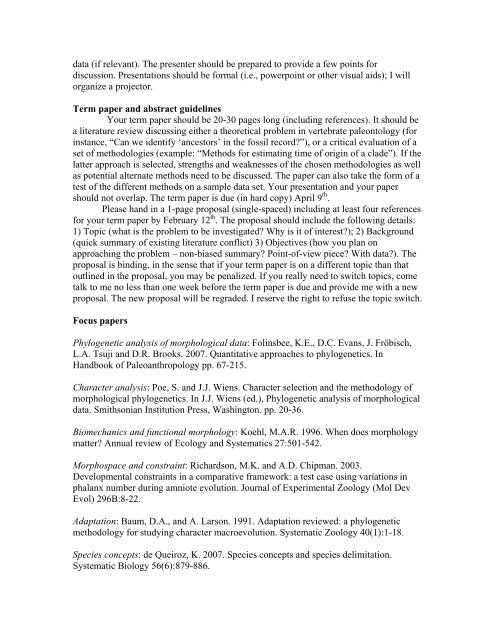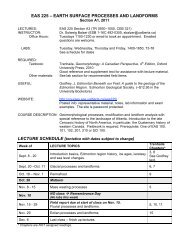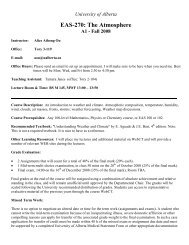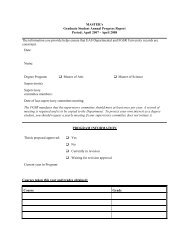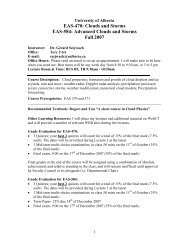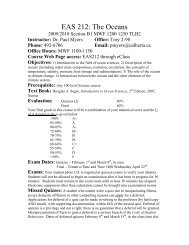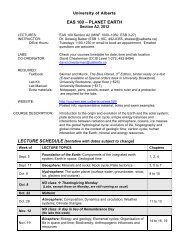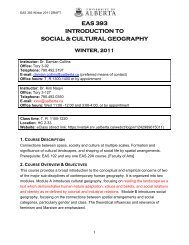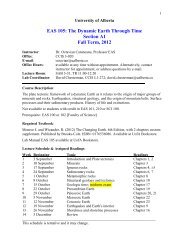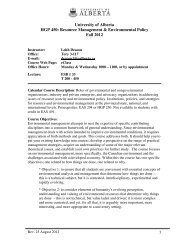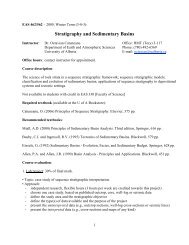PALEO 520 Syllabus Time: Room: Instructor Erin Maxwell Office ...
PALEO 520 Syllabus Time: Room: Instructor Erin Maxwell Office ...
PALEO 520 Syllabus Time: Room: Instructor Erin Maxwell Office ...
You also want an ePaper? Increase the reach of your titles
YUMPU automatically turns print PDFs into web optimized ePapers that Google loves.
data (if relevant). The presenter should be prepared to provide a few points for<br />
discussion. Presentations should be formal (i.e., powerpoint or other visual aids); I will<br />
organize a projector.<br />
Term paper and abstract guidelines<br />
Your term paper should be 20-30 pages long (including references). It should be<br />
a literature review discussing either a theoretical problem in vertebrate paleontology (for<br />
instance, “Can we identify ‘ancestors’ in the fossil record?”), or a critical evaluation of a<br />
set of methodologies (example: “Methods for estimating time of origin of a clade”). If the<br />
latter approach is selected, strengths and weaknesses of the chosen methodologies as well<br />
as potential alternate methods need to be discussed. The paper can also take the form of a<br />
test of the different methods on a sample data set. Your presentation and your paper<br />
should not overlap. The term paper is due (in hard copy) April 9 th .<br />
Please hand in a 1-page proposal (single-spaced) including at least four references<br />
for your term paper by February 12 th . The proposal should include the following details:<br />
1) Topic (what is the problem to be investigated? Why is it of interest?); 2) Background<br />
(quick summary of existing literature conflict) 3) Objectives (how you plan on<br />
approaching the problem – non-biased summary? Point-of-view piece? With data?). The<br />
proposal is binding, in the sense that if your term paper is on a different topic than that<br />
outlined in the proposal, you may be penalized. If you really need to switch topics, come<br />
talk to me no less than one week before the term paper is due and provide me with a new<br />
proposal. The new proposal will be regraded. I reserve the right to refuse the topic switch.<br />
Focus papers<br />
Phylogenetic analysis of morphological data: Folinsbee, K.E., D.C. Evans, J. Fröbisch,<br />
L.A. Tsuji and D.R. Brooks. 2007. Quantitative approaches to phylogenetics. In<br />
Handbook of Paleoanthropology pp. 67-215.<br />
Character analysis: Poe, S. and J.J. Wiens. Character selection and the methodology of<br />
morphological phylogenetics. In J.J. Wiens (ed.), Phylogenetic analysis of morphological<br />
data. Smithsonian Institution Press, Washington. pp. 20-36.<br />
Biomechanics and functional morphology: Koehl, M.A.R. 1996. When does morphology<br />
matter? Annual review of Ecology and Systematics 27:501-542.<br />
Morphospace and constraint: Richardson, M.K. and A.D. Chipman. 2003.<br />
Developmental constraints in a comparative framework: a test case using variations in<br />
phalanx number during amniote evolution. Journal of Experimental Zoology (Mol Dev<br />
Evol) 296B:8-22.<br />
Adaptation: Baum, D.A., and A. Larson. 1991. Adaptation reviewed: a phylogenetic<br />
methodology for studying character macroevolution. Systematic Zoology 40(1):1-18.<br />
Species concepts: de Queiroz, K. 2007. Species concepts and species delimitation.<br />
Systematic Biology 56(6):879-886.


